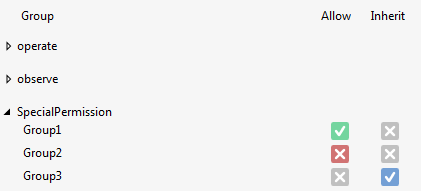Defining and using virtual permissions of a user control
Defining virtual permissions
- 1. Open the parameter editor of the user control.

- 2. Under Virtual Permissions, add the desired additional user control access methods. The following properties can be configured here:
Name: Unique name of the virtual permission
Description: Description used as a tooltip Additional properties are displayed if you activate the Details checkbox:
Additional properties are displayed if you activate the Details checkbox:
Internal Name: Internal name used in HTML code (corresponds by default to "Display Name").
Display Name: Name displayed to the user in the engineering (corresponds by default to "Name").
Visible: Visibility of the virtual permission for the user in the engineering.
Default Value (Internal): Default return value of the virtual permission if the query of the current permissions situation does not produce a return value.
- 3. Confirm your input with OK.
Using virtual permissions
- 4. Select a control inside the user control in the designer.
- 5. Assign a virtual permission for the desired access method to the selected control, which is to represent a special access method of the user control to the outside.


The desired access method is now no longer configurable inside the user control. However, it is available for configuration through the assignment of the virtual permissions as an additional access method of the user control host when using the user control in the designer.

 | For the purpose of reusability of the user control, direct configuration of the access methods inside a user control should be dispensed with. The independence of project-specific user groups is achieved with this approach. Accordingly, the default access methods "Observe" and "Operate" should be configured either with "Inherit" or as special access methods via the use of virtual permissions. Special access methods of controls within a user control should always be fed to the outside via the use of virtual permissions because the user control host only has the default access methods "Observe" and "Operate" as standard. |